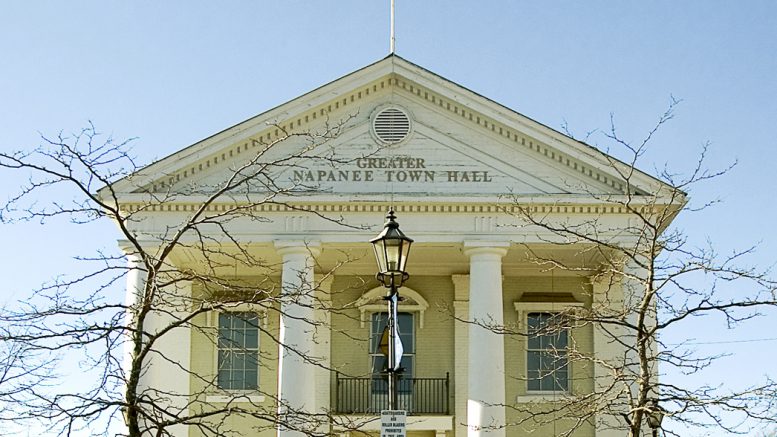Sarah Williams
For the Beaver
The specter of dead and dying trees was cast upon the Town of Greater Napanee council chambers when Jeff Chestnut made an impassioned deputation about the plight of ash trees. These trees dot the landscape of Lennox and Addington County and are being desecrated by the Emerald Ash Borer.
This bug, a non-native species from Asia, has been slowly wreaking havoc on local Ash Trees since 2002.
Unfortunately, the widespread effect of this insect is becoming increasingly apparent, as dead trees can be found throughout the town and countryside.
Chestnut said he began to notice the trees were in danger when doing some gardening.
“I looked around and noticed the death of trees around here is staggering,” he stated.
The ash tree plays an important role in the local ecosystem, commented Chestnut, adding that it is also important for Indigenous traditions.
“This tree plays a big part in Indigenous life around here. It’s used in traditional basket making, for example. It was also used to make furniture, cabinets, and flooring. Green and black ash grow in our wetlands,” said Chestnut. “The leaves feed tadpoles. The root base of the ash tree helps change the pH level of the soil, allowing other hardwoods to grow. That’s why we have such a unique forest in this area. We have hardwoods and softwoods. If that changes, other trees will get sick too.”
The interconnectedness of an ecosystem is vast, noted Chestnut, with over 1,000 species relying on the Ash Tree for food. Some of these are wood mice, lichen, wrens, bats, and fungi, to name a few.
“Another creature that eats the seeds are ducks and turkeys. Our hunting will be affected,” he said. “The local duck population is a tenth what it was 10 years ago.”
Chestnut points to the federal and provincial government’s ineffective tactic to address the Emerald Ash Borer problem.
“We have this belief that the internet is our saviour. When the bug hit in 2002, the federal government put a 1-800 number on their webpage. Now, the provincial government has done the same,” bemoaned Chestnut.
The problems caused by dead ash trees are many. Chestnut defined a few as: unexpected roadblocks, building and fence damage, soil impairment/erosion/change in pH, lack of food for native species, and the choking of forest regrowth for decades, if not a century.
“We have to do something,” added Chestnut.
While the issue is clear, a solution to the Emerald Ash Borer problem remains to be seen. For the most part, Chestnut provided council with possible ways to mitigate the negative outcomes from the many dead and dying trees.
He argued this issue needs to be included in budget considerations and suggested the following bylaws might also be considered:
-Restrict all planting of ash; implement $2,000 fines
-Create an accepted tree list and ensure area outlets for plants are not selling ash or other invasive species
-Restrict the selling of ash wood for any purpose; firewood, building materials and pallet material
-Replace dead ash at Springside Park (over 10 dead Ash Trees along the river shoreline).
Councillor Dave Pinnell Jr. asked if there might be a way to rectify the situation.
“Based on your research, is there any way of getting rid of this species other than starving it?” questioned Pinnell.
Chestnut responded that, in fact, there is no way to get rid of this species as it is invasive. The Emerald Ash Borer, he made note, has recently been found as far away as Western Canada.
The deputation by Chestnut was received as a Norrie/Calvert Motion.
-In other council news, Sept. 17-23 has been proclaimed National Legion Week in the Town of Greater Napanee.
“Ontario Provincial Command of The Royal Canadian Legion represents nine districts which includes 390 Branches, with a membership of over 89,000 members,” read Councillor Bob Norrie. “For the first time, Legion Week will be celebrated nationally.”
-Council also discussed the staff recommendation of a split of proceeds 1/3 to Town Reserves to pay for the purchase of 99 Advance, and 2/3 to Utilities Capital Reserves for the construction of the Maintenance Garage at the Water Pollution Control Plant.
Councillor Pinnell sought clarification regarding the numbers provided in the staff report.
“When we look at the numbers provided the sale of property was $1.5 million and at end of day we have $965,000 left to divvy up …it seemed there was $470,000 dollars that didn’t appear on this. Is that the assessed value of that you assured me will be going into the general account?” questioned Pinnell.
Interim deputy treasurer Nathan Murphy confirmed this amount would be placed in the general account.
-For those awaiting the upcoming budget deliberations, council formally approved the dates on which budget items will be discussed. These are as follows:
- Oct. 26, 2023 – Fire Master Plan and Community Risk Assessment; Waste Diversion Committee Presentation
- Presentation of the Waste Diversion Committee recommendations and potential input on the waste collection surcharge
- Nov. 2, 2023 – Utilities Capital and Operating Budget
- Inclusive of projected rates for 2024.
- Nov. 16, 2023 – Town Operating
- Overview of each department with any specific major operating changes
- Dec. 6, 2023 – Town Capital
- Departmental Capital requests and proposed funding strategies
- Jan. 18, 2024 – Final
- Culmination of Town Operating and Capital with overall Tax Levy for the 2024 fiscal year and direction to prepare a bylaw.
Of note, the deliberations were intended to begin Oct. 12, with an amendment made to amalgamate the 12 with the 26 meeting.
“There’s concern the waste diversion information may not be fully ready for Oct. 12 so a request to defer was made,” explained Jessica Walters, town clerk.
The budget dates were approved as a Hicks/Schenk motion.

